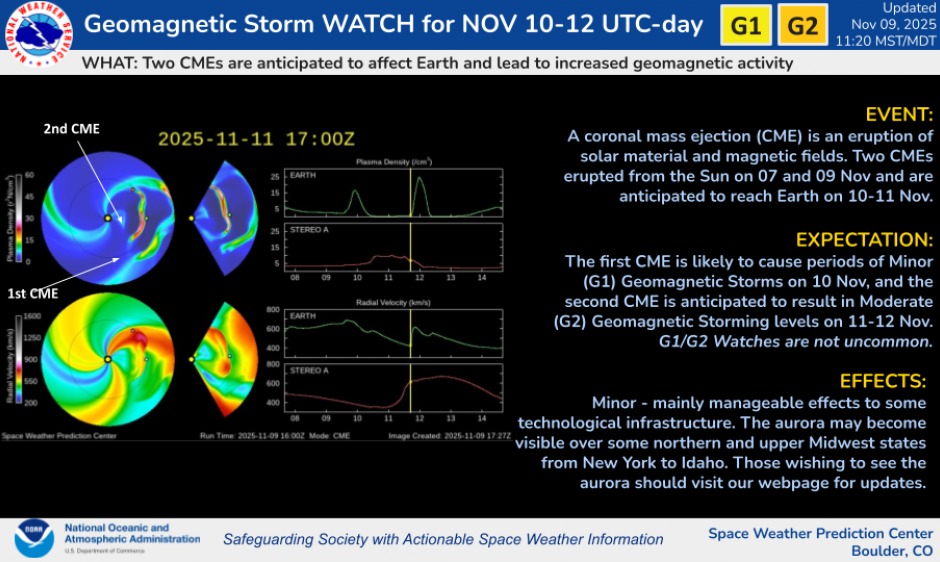Solar activity has kicked into high gear already this week with two powerful X-class solar flares erupting from active region AR4274 — one on Nov. 9 and another early Nov. 10 — each potentially firing coronal mass ejections (CMEs) toward Earth.
Coronal mass ejection released during the X flare eruption on Nov. 10, 2025. (Image credit: NOAA Space Weather Prediction Center)
Together, the events have prompted NOAA to issue a G1 (minor) geomagnetic storm watch for Nov. 10 and a G2 (moderate) watch for Nov. 11-12. These levels can impact satellites and power systems and can help boost auroras across northern U.S. states from New York to Idaho, as well as parts of northern Europe.
You may like
But that’s not all! Space weather forecasters and aurora chasers are keeping a close watch on the aftermath of a second X-flare from the same region just this morning (Nov. 10), which unleashed another CME toward Earth. The flare measured as an X1.2 eruption, peaking around 4:20 a.m. EST (0920 GMT).
HUGE symmetrical full-halo CME from the X1.2 flare in AR 4274! This one is headed directly at us. This is a big one! Chances for major geomagnetic storms this week are rising rapidly! https://t.co/VPQNvzoTeU pic.twitter.com/aYsGk5Wpn2November 10, 2025
What’s next?
At least two CMEs are en route to Earth, one from Nov. 7, which could brush past today, and another from the Nov. 9 X1.7 flare, expected to arrive around Nov. 11-12.
A third, potentially larger CME linked to this morning’s Nov. 10 X1.2 flare is now under analysis. Space weather forecasters are reviewing new coronograph imagery from NASA’s SOHO and STEREO spacecraft to determine its speed and trajectory. That assessment should be available within the next 12-24 hours, at which point forecasts and geomagnetic storm alerts may be updated accordingly.
NOAA’s geomagnetic storm watch for Nov. 10-12. (Image credit: NOAA Space Weather Prediction Center)What’s an X-flare?
X1.2 solar flare eruption on Nov. 10, 2025. (Image credit: NOAA Space Weather Prediction Center)
A solar flare is a sudden, intense burst of energy from the sun caused by the sudden release of magnetic energy in an active sunspot region. These outbursts send radiation and charged particles hurling into space and can disrupt communications on Earth if the flare erupts from an Earth-facing sunspot.
X-class solar flares are the most powerful category of flares. The number that follows the X indicates its strength, with each step representing a coupling in power, meaning an X2 flare is twice as strong as an X1.




